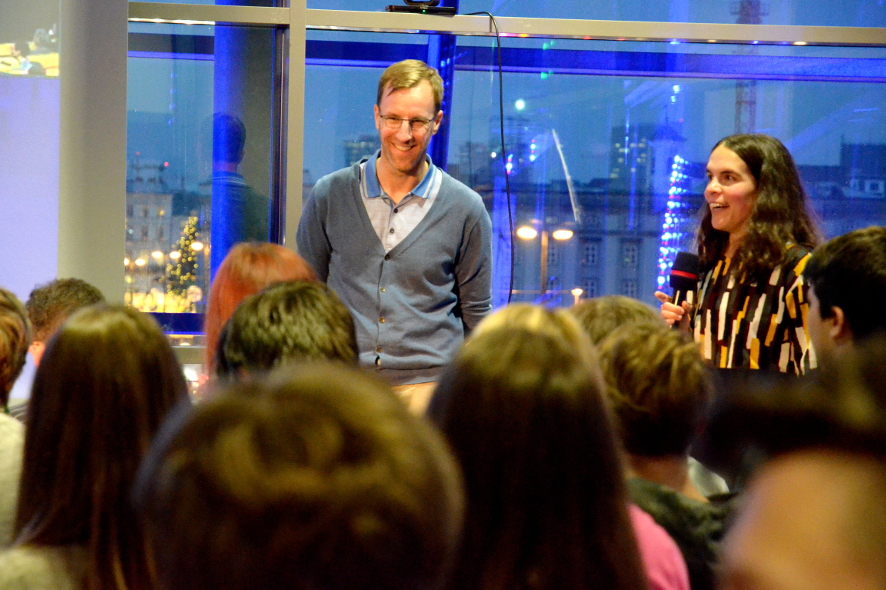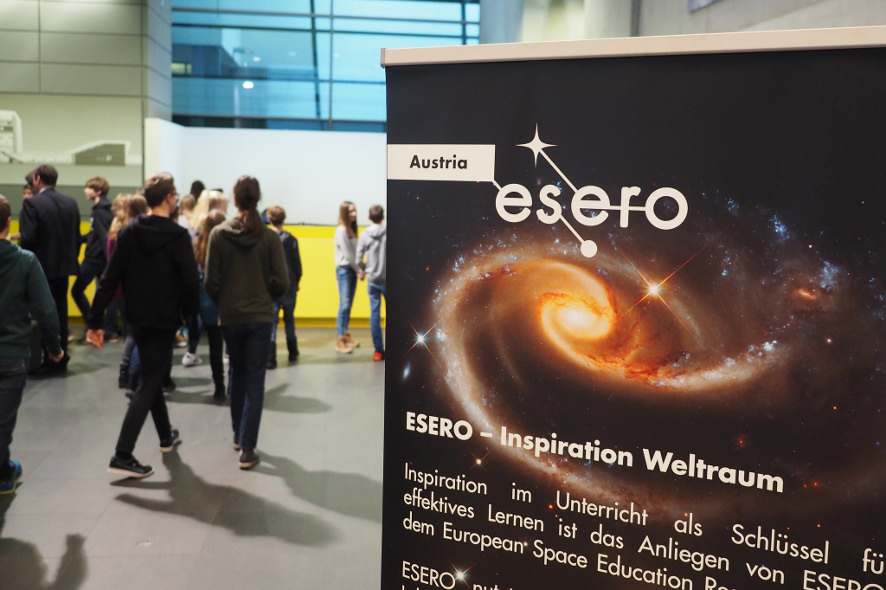FFG stands for Österreichische Forschungsförderungsgesellschaft and is, according to its own definition, “an organisation for the promotion of research and innovation in the field of application-oriented and industry-oriented research in Austria”. More precisely, this means that the FFG supports research projects of companies and scientists in Austria, among other things. The Aeronautics and Space Agency is also part of the FFG. It represents Austria’s interests at the European Space Agency (ESA). And Andreas Bauer, Museum Director of the Ars Electronica Center and ESERO Austria supervisor, has recently joined its Advisory Board. After ESERO Austria celebrated its second birthday in June, we have reason enough to talk to Andreas about his new position and the last two years of ESERO Austria.

Credit: Magdalena Sick-Leitner
Hello Andreas! Congratulations on your new position as a member of the FFG Advisory Board for Aerospace! This fits perfectly to your job as a supervisor at ESERO Austria. What do the two institutions have in common?
Andreas Bauer: Thank you very much! Yes, that’s right! The two have a common passion, the subject of space. They both want to increase the importance of space research in Austria. ESERO Austria’s task is to do this in the context of the school: how can teachers be motivated to make science and technology lessons more exciting with the help of the fascination of space? The Advisory Council for Aeronautics and Space does exactly the same thing, only on an institutionalised level: what and where is space research being conducted in Austria, which companies are active in this field, what developments are there on the part of the Federal Ministry of Transport, Innovation and Technology and what recommendations can they make so that this can be promoted even more? ESERO Austria is now also a member of this advisory board to emphasize the educational aspect. We, as ESERO, ideally ensure the next generation at these companies, when our young people are fascinated by the subject of space, for example when they start studying at the TU Vienna or start an apprenticeship at RUAG, and then work in this area later on.

Credit: Martin Hieslmair
Thanks to the support of the FFG and the Bmvit, ESERO Austria has already organised great events over the past two years, such as the In Flight Call to the ISS at the end of last year. Can you tell us more about it?
Andreas Bauer: The opportunity to speak live with an astronaut on the International Space Station is one that is very rare, because their schedule is extremely tight. Paulo Nespoli, with whom we spoke, was on the ISS for four and a half months and during that time he had only 60 minutes in total to devote to education and this In Flight Call took about 20 to 25 minutes. This shows how strictly planned the everyday life of an astronaut on the ISS is. To know that someone is flying 400 kilometres above me to answer my questions – just the possibility that this communication exists – is totally fascinating. And that is exactly the task of ESERO: to use this fascination and to inspire students.

Credit: Magdalena Sick-Leitner
In 2016, even real astronauts were with us at the Ars Electronica Center…
Andreas Bauer: Exactly! There is an association of astronauts, the Association of Space Explorers. This means that if you were an astronaut, you can become a member of this association. These members meet once a year and in 2016 this several-day meeting took place in Austria on the occasion of the 25th anniversary of the Austromir Mission – the visit of Franz Viehböck to the space station Mir. One day of this was planned for them to talk to the population about their work. To this end, the astronauts visited various institutions throughout Austria. And so three astronauts, such as Michael Fincke, joined us at the Ars Electronica Center. He was extremely impressed by the Deep Space in our museum, because the ISS in the “Uniview” program can be viewed three-dimensionally from all directions by means of live control. For a whole day without a break, he was able to give the school classes a vivid account of life on the ISS, the names of the individual parts of the ISS, the size of things and how they live in them.

Credit: Martin Hieslmair
Franz Viehböck, the first and only Austrian astronaut mentioned above, now regularly visits the Ars Electronica Center for the closing events of “Mission X”, which is organized by ESERO Austria…
Andreas Bauer: Mission X is aimed specifically at elementary schools and the motto is “Train like an astronaut”. For me, Mission X is a very nice example of how the transfer of space issues to a class can work. The children train to become astronauts and the exercises they do are based on real astronaut training. Actually, it is about the right nutrition, a healthy body and mental fitness. This means, in reality, that we are dealing with quite banal topics that we encounter in everyday life. And this is how you teach children why it is important to eat healthily and to be active in sports. And they simply prefer it when they know that this is the same food that astronauts eat and are the same exercises that astronauts do. This is not about solving difficult technical problems or so on, but primarily about having healthy children. Getting to know the first and only Austrian astronaut, Franz Viehböck, then at the final event of the project is of course the highlight of every school class that took part.

Credit: Vanessa Graf
A few young Austrian astronauts and rocket scientists took part in the first CanSat competition in Austria this year as part of ESERO Austria…
Andreas Bauer: CanSat is already a more difficult challenge. The task is to carry out a satellite mission on a small scale. This means building an Earth’s atmosphere satellite and considering which missions this satellite must perform. The ESA specifies the primary mission. This is the measurement of air pressure and temperature. And a second secondary mission – the language, by the way, is analogous to a real space mission – they have to consider themselves. The satellite they are building is the size of a beverage can and is mounted by us together with the TU Space Team on a rocket and fired at a height of 500 meters, is then ejected, then falls down on a parachute and has to make its measurements. The teams must then scientifically evaluate the data received from the satellite and present it to a jury. So it really is a small-scale satellite mission. A big satellite works the same way. So this is really a great achievement of the teams that took part in the CanSat competition.

Credit: Magdalena Sick-Leitner
And what can we expect from ESERO Austria in the near future?
Andreas Bauer: The main focus of ESERO is actually the teachers. Mission X, CanSat and Co. are very nice projects, but the main task is to support teachers in the task of making science and technology education more exciting with space. In this respect, a very diverse programme awaits teachers and teachers in the coming semesters. What is special about ESERO Austria is that we will be giving it an artistic-creative approach, since it is located in the Ars Electronica Center. Teaching materials are also available from other ESERO offices in other countries, but since the Ars Electronica Center deals with art, technology and society, this naturally also has an impact on ESERO Austria.
Among other things, we are revising workshops that we already offer at the Ars Electronica Center by incorporating the topic of space, such as the “Future Matters” workshop, which deals with materials of the future. We also have a Space Material Kit at the Ars Electronica Center, where you can attack space materials and find out what is the ideal material to build a rocket. With the Regional Competence Center for Natural Sciences and Mathematics (RECC) Vienna and nine committed teachers, we have already completed four teaching modules and tested them in the classroom. These are still being prepared graphically and will soon be available for school classes throughout Austria. Five further modules are still in the test phase. Once the resources are approved, they will expand our resource pool. Of course, Mission X and CanSat will be carried out again and much more. So it will definitely remain exciting.
To learn more about Ars Electronica, follow us on Facebook, Twitter, Instagram et al., subscribe to our newsletter, and check us out online at https://ars.electronica.art/news/en/.
